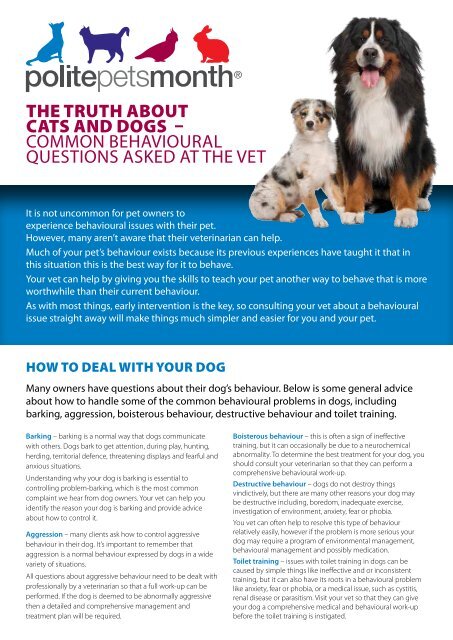The TruTh abouT caTs and dogs - Australian Veterinary Association
The TruTh abouT caTs and dogs - Australian Veterinary Association
The TruTh abouT caTs and dogs - Australian Veterinary Association
You also want an ePaper? Increase the reach of your titles
YUMPU automatically turns print PDFs into web optimized ePapers that Google loves.
<strong>The</strong> truth aboutcats <strong>and</strong> <strong>dogs</strong> –common behaviouralquestions asked at the vetIt is not uncommon for pet owners toexperience behavioural issues with their pet.However, many aren’t aware that their veterinarian can help.Much of your pet’s behaviour exists because its previous experiences have taught it that inthis situation this is the best way for it to behave.Your vet can help by giving you the skills to teach your pet another way to behave that is moreworthwhile than their current behaviour.As with most things, early intervention is the key, so consulting your vet about a behaviouralissue straight away will make things much simpler <strong>and</strong> easier for you <strong>and</strong> your pet.How to deal with your dogMany owners have questions about their dog’s behaviour. Below is some general adviceabout how to h<strong>and</strong>le some of the common behavioural problems in <strong>dogs</strong>, includingbarking, aggression, boisterous behaviour, destructive behaviour <strong>and</strong> toilet training.Barking – barking is a normal way that <strong>dogs</strong> communicatewith others. Dogs bark to get attention, during play, hunting,herding, territorial defence, threatening displays <strong>and</strong> fearful <strong>and</strong>anxious situations.Underst<strong>and</strong>ing why your dog is barking is essential tocontrolling problem-barking, which is the most commoncomplaint we hear from dog owners. Your vet can help youidentify the reason your dog is barking <strong>and</strong> provide adviceabout how to control it.Aggression – many clients ask how to control aggressivebehaviour in their dog. It’s important to remember thataggression is a normal behaviour expressed by <strong>dogs</strong> in a widevariety of situations.All questions about aggressive behaviour need to be dealt withprofessionally by a veterinarian so that a full work-up can beperformed. If the dog is deemed to be abnormally aggressivethen a detailed <strong>and</strong> comprehensive management <strong>and</strong>treatment plan will be required.Boisterous behaviour – this is often a sign of ineffectivetraining, but it can occasionally be due to a neurochemicalabnormality. To determine the best treatment for your dog, youshould consult your veterinarian so that they can perform acomprehensive behavioural work-up.Destructive behaviour – <strong>dogs</strong> do not destroy thingsvindictively, but there are many other reasons your dog maybe destructive including, boredom, inadequate exercise,investigation of environment, anxiety, fear or phobia.You vet can often help to resolve this type of behaviourrelatively easily, however if the problem is more serious yourdog may require a program of environmental management,behavioural management <strong>and</strong> possibly medication.Toilet training – issues with toilet training in <strong>dogs</strong> can becaused by simple things like ineffective <strong>and</strong> or inconsistenttraining, but it can also have its roots in a behavioural problemlike anxiety, fear or phobia, or a medical issue, such as cystitis,renal disease or parasitism. Visit your vet so that they can giveyour dog a comprehensive medical <strong>and</strong> behavioural work-upbefore the toilet training is instigated.
How to co-exist with your catIn co-existing with us, cats can sometimes developbehaviours that may cause problems for their owners. <strong>The</strong>most common problems we see in cats include sprayingor eliminating on furniture <strong>and</strong> carpets, scratchingindoors, hunting, hiding <strong>and</strong> yowling.Hunting<strong>The</strong> first step in addressing any concern you have with your cat or dog is to take them to your vet to check if there is anunderlying medical condition that could be causing the problem. Once this has been determined you can begin to look atunderst<strong>and</strong>ing the motivation for their problem <strong>and</strong> determine the best treatment for your four-legged family member.<strong>Australian</strong> <strong>Veterinary</strong> <strong>Association</strong> LtdABN 63 008 522 852Unit 40, 6 Herbert Street St Leonards NSW 2065T. 02 9431 5000 F. 02 9437 9068E. members@ava.com.auPolite Pets Month is proudly supported by Royal Canin <strong>and</strong> CEVA Animal Health

















